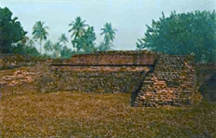Chandraketugarh
Chandraketugarh an archaeological site. Located on the Vidyadhari, once an important tributary of the Bhagirathi, Chandraketugarh (Chandraketugad) is situated 35 kilometres northeast of calcutta in the district of 24 Parganas of West Bengal. Excavations at the site for several years have revealed materials, which prove the antiquity of the site and its archaeological importance. The excavated material is in the collection of the asutosh museum and the State Archaeological Museum, Calcutta, and in addition there are a number of private collections in and around the town.

The settlement dimension of the site spreads over a wider area comprising the present day villages of Devalaya, Hadipur, Berachampa, Shanpukur, Jhikra and Itakhola. However, it must be said that the chronological correlation of the different structural phases has not been done satisfactorily. A huge rampart wall made of mud encircled the core area of the place, rectangular in shape, and spreading over roughly one square mile. The digging at Chandraketugarh, Khanamihirer Dhibi, Itakhola and Nungola - all within the rampart walls - have laid bare five occupational periods.
While Period I represents a thin layer of pre-NBPW level, Period II, belonging to a period from c 400 BC to 100 BC is characterized by the use of a red ware in the shape of a long necked jar, big rimless round cups and bowls, NBP wares in black, gold and purple shades, sherds of plain grey colour, fragmented pieces of ivory and copper antimony rods, punch marked copper coins, uninscribed cast copper coins, and a fairly good number of terracottas, including a large number of beads, seals and sealings. Period III, contemporary with the Kusanas and apparently the most prosperous, has yielded fine pieces of diagnostic rouletted pottery of Roman affiliation, broken pieces of amphorae sherds in black or mat-red, fine red pottery with stamped design, grey pottery, and finely moulded terracotta figurines.
This period is assignable to about the first three centuries of the Christian era. Period IV, ascribable to Gupta and late Gupta times, is marked by its yield of typical seal and sealings, terracottas and stamped and moulded pottery. The most important find of this period is the more than fourteen feet high remains of a massive sarvata-bhadra-type of brick temple with reentrant angles. No cult object was found to connect the shrine with any particular deity. However the lower part of a sand stone plaque representing the figure of Surya has been found in the Gupta deposit. The archaeological evidence of period V, belonging possibly to the Pala phase, is very limited.
On the evidence of art objects it is clear that the principal artistic medium of the site from the Maurya through the Gupta periods was the terracottas made from moulds. In all meaningful aspects this art in its stylistic affiliation seems to run a parallel course with those art objects of Gangetic India of c 350 BC through to c 500 AD. They reveal the astonishing thematic variety which is characteristic of this school. These range from religious and ritualistic objects like primitive earth goddess, yaksa, yaksinis, nagas, male or female figures, at times standing on wheeled animals, and winged deities, to types and forms which are frankly secular. It is among the terracotta assemblages of the first three centuries of the Christian era that one comes across imprints of Graeco-Roman contacts in dress and/or in physiognomic features. Chandraketugarh has provided for us a deluge of terracottas depicting amorous couples shown in dalliance or in maithuna postures. The male and female figurines with intricate ornamentation are suggestive of imitation of the gold smith's craft.
The site still remains to be definitely identified. But there is reason to believe that this was possibly the ancient 'Gange', a place mentioned both by Periplus and Ptolemy. [Amita Ray]
